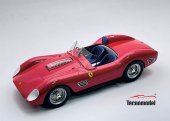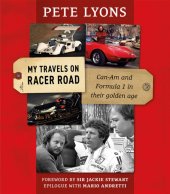ISSUE #20 - English Edition
COVER STORY
Dan Gurney's
AAR Eagle MkIII Toyota
SUCCESS STORY - 50 Years of the International Motor Sports Association
FULL-BLOODED - The glory days of prototypes in the IMSA series between 1981 and 1993
SERIAL WINNER - AAR Eagle MkIII Toyota GTP
THE OTHER FANGIO - Juan Manuel Fangio II
SERIAL WINNER
AAR Eagle MkIII Toyota GTP
No other car dominated the IMSA GTP series as thoroughly as the Eagle MkIII did during its two full seasons of racing. Dan Gurney’s All American Racers entered 27 races with the GT prototype, winning 21 – an impressive record achieved through driver skill, good teamwork at the track, and most importantly of all, some ingenious technological innovations that set new trends in GT car design. Chassis designer John Ward was one of the men tasked with creating the MkIII. For AUTOMOBILSPORT, he lays out the technology behind this iconic car.
To understand the development history of the Eagle MkIII, one has to know a little bit about IMSA GTP racing. The series started in 1981 with mostly Chevrolet-powered privateer entries, but in 1984 Porsche introduced its 962 chassis, which was the car to beat from 1985 to 1987. Over time, more manufacturers got involved. From 1988 to 1991 the Nissan factory-backed cars dominated over Porsche, Chevrolet, Jaguar, Mazda, and Toyota.
In late 1991 the Eagle MK III made its debut at Laguna Seca, qualifying second and dominating the race. However, it did not win, due to a pit stop infraction as I remember. The next race at Portland, the car scored its first victory with Juan Manual Fangio II, the nephew of the legendary Formula 1 world champion, at the wheel. It won again at the season finale at Del Mar. From then on, the MkIII was virtually unbeatable, winning 19 out of 26 races in 1992 and 1993, and the championship each year. 14 of those wins came in succession – actually, the car won all of the last 17 races it entered (it did not start at Road America in 1993).
The chassis and aerodynamic rules were loosely based on European FIA Group C prototype chassis rules. But whereas the Group C cars raced with fuel mileage restrictions, there was no such limit in the IMSA GTP. The engines were restricted with ‘sonic’ orifices, however, to limit engine air intake flow and hence power.
Dan Gurney and AAR had given me my start back in 1976, and my heart was always there no matter where I was. I had gone off to explore other opportunities after 1981, but in late 1989 I jumped at the chance to design a new GTP car when Dan offered. The moment I saw these cars run, I was hooked. They were governed by a pretty free set of rules, had a lot of power, and were technically very challenging – just what Dan, AAR, and designers like me wanted…
by John Ward
Photographs: Marshall Pruett, Gary Donahoe, Jutta Fausel, AAR, Motorsportimages, John Hutnick, Mike Cook
FULL-BLOODED
The glory days of prototypes in the IMSA series between 1981 and 1993
The two-seater prototypes running in the IMSA GTP class represented the very top of sports car racing in the USA. From a technical perspective they were the same Group C cars that ran in the World Championship between 1982 and 1992. However, there was one key difference in the US: no limit on fuel consumption. Derek Bell, one of the most famous sports car drivers of the 1980s, summed up the attitude of the Americans in a single phrase: ‘Race fans do not come to races to watch an economy run.’
The FIA introduced Group C ahead of the 1982 World Endurance Championship. In the USA, purebred prototypes had been allowed under the GTP rules since 1981. This opened the door for the new Lola-Chevrolet and March-Chevrolet cars to compete. However, in 1981 and 1982 they were still usually beaten by the reliable Porsche 935. In 1981 the title went to Brian Redman in a Porsche, followed by John Paul Jr in the same make a year later. The ageing 935 did start to lose some ground to the modern prototypes, including the fascinating Jaguar XJR-5 run by Bob Tullius and his Group 44 team from the autumn of 1982. But at the end of 1983, Porsche was still a winner – albeit as an engine supplier for Al Holbert’s March 83G, which had made a mid-season switch from Chevrolet power.
Porsche developed the outstanding 956 for Group C, but the car didn’t comply to IMSA regulations. The main issue was the length of the crash structure ahead of the front wheels, which didn’t meet IMSA standards. With Porsche wanting to offer its US customers a competitive prototype, it developed the 962 using the 956 as a base. The updated car was used from the beginning of the 1984 season and won for the first time at Mid-Ohio in June. While the ’84 title went to Randy Lanier in his Chevrolet-March, the 962’s progress couldn’t be stopped.
With the exception of the Road Atlanta race, won by the Jaguar XJR-5, the 962 was unbeatable in 1985. It made for an easy championship win for Holbert. Things were much the same in 1986 and 1987, with the Porsche the car to beat. There were isolated wins for Buick, Chevrolet, Ford and Jaguar, but Porsche won both manufacturers’ titles and Holbert and Chip Robinson split the drivers’ titles…
by Thomas Nehlert
Photographs: Motorsportimages, Michael Keyser, Peter Hoffmann
RENAULT’S RALLY BOMB
The R5 Turbo and Maxi Turbo
During the 1970s, Renault’s main involvement in rallying was with the Alpine Renault A110 which, among many other successes, won the inaugural World Rally Championship for Manufacturers in 1973 as well as the Monte Carlo Rally in 1971 and 1973. Coincidentally, it was 1973 when Renault acquired the Société des Automobiles Alpine, and for a while, they continued to use the A110 and its big brother, the A310 V6, in rallies. But there was always the desire to do something with a car of their own, bearing the name Renault.
In 1977 at the instigation of Jean Terramorsi, a senior vehicle production director within Renault, Project 822 was initiated with the purpose of creating a high-performance car based on the Renault R5 that could also be a rally winner. One of Terramorsi’s assistants given charge of the project was Henry Lherm, based at the Alpine factory in Dieppe. Work was very quickly underway with Yves Legal concentrating on the design, and Serge Masset and Phillippe Chasselut developing the engine. The emphasis on the engine was due to the fact that Renault had brought its turbocharged engine into Formula 1 in 1977 with the RS01, and it had been decided that this relatively new motorsport technology should also power their new rally car. In short, after various experiments with a two-litre V6 engine from the R20, the proposal was to turbocharge the 1,397 cc four-cylinder engine of the R5 to give 160 bhp in road-going form.
Naturally, it had been clear from the start that with a major increase of power over a standard R5 engine, it would be best to have the engine driving the rear wheels rather than the front. Both the Alpines and the all-conquering Lancia Stratos appeared to show the way. In any case, it was always going to be difficult to have the engine, its radiators plus the gearbox and a turbocharger all under the modest bonnet of an R5. However, if the engine and transmission could be removed from its transverse location in the front of the R5 where it drove the front wheels, then many potential problems would disappear. The solution at which they finally arrived was to lift the engine, rotate it by 180 degrees and place it in the centre of the R5 with the gearbox behind it.
The first inkling of what the car was to be came at the Salon de l’Auto in Paris in 1978 when a mock-up of the new car was put on show, without an engine. During the next twelve months, a selection of journalists was shown prototype versions of the car with slightly different installations of the engine, and finally the definitive R5 Turbo was revealed at the Paris Salon of 1980. The car boasted an interior and exterior designed by Bertone with light alloy doors, bonnet and boot, and plastic extensions to bring the kerb-weight down to 970 kg. The modifications needed to make a suitable bodyshell from that of a standard R5 were carried out at the Heuliez factory at Cerizay, away to the west of Paris. These bodies were then delivered to the Alpine factory in Dieppe. Heuliez had already completely manufactured the Renault 5 Le Car Van, so they were familiar with modifying R5 bodyshells…
by John Davenport
Photographs: McKlein, Renault
Willi World Champion
or The Turbulent Life and Times of Willi Kauhsen
Willi Kauhsen had a varied career in motorsport. He won the 1967 European Touring Car Championship with an Abarth, was a Porsche works driver, and eventually founded his own racing team. In the late 1970s, the Aachen native even made a brief foray into Formula 1 with his own car, which turned out to be an utter failure. The ‘Willi Kauhsen Racing Team’ was considerably more successful in sports car racing: in 1975 team boss Kauhsen won the World Championship for Makes with Alfa Romeo.
His father sent him into races with the words ‘drive slowly, but win’. His mother, a devout Catholic, lit a candle before each race and wouldn’t extinguish it until after she’d spoken to him on the phone. Wilhelm Hubert, known as Willi, was his name. He was the oldest child of a freight forwarder from Aachen, Germany. He obtained his driving licence at the age of 16 thanks to a special permit, and he loved to travel to the Nürburgring – even before he had a car.
His first car stood in his parents’ yard in 1960, a Porsche 356 Super 90. From that moment Willi was fixated on nothing other than motorsport. He took part in races at airfield circuits, hillclimbs, and whatever else the Super 90 was eligible for. His idol wasn’t Wolfgang von Trips, but rather Jo Bonnier. He even grew a beard similar to that worn by the Swede, who died at Le Mans in 1972 in a Lola.
In his early years no car was too small for Willi. He drove everything from a Mini to a BMW, from a Steinmetz Commodore to an Abarth 1300 OT. He even became a European Touring Car Champion in 1967 with a 1000 TC. His real love, however, was Porsche, and he could be found in a 906, a 910, and a number of different 911s. Race director Huschke von Hanstein spotted Kauhsen’s obvious talent, and at the beginning of the 1960s offered to help turn the Super 90 into a real racing car. When Willi towed the no longer street-legal Porsche back to Aachen behind a company truck, his father didn’t even recognise it any more. Where had that beautiful cabriolet gone? But ultimately, Kauhsen Sr even paid for the conversion, which Hanstein knocked down to 4,500 marks from the original 8,000 marks.
For two years Willi shone in the Super 90, and survived the numerous protests from suspicious rivals who accused the newcomer of being too quick. The race driver in making had no time for further education or to learn any foreign languages. He had his father’s support: ‘You don’t need foreign languages. You’ll take over the company, anyway.’…
by Yörn Pugmeister
Photographs: Porsche Kremer, Willi Kauhsen, Porsche, Michael Keyser, McKlein, Müllender, Kräling
ALSO IN THIS ISSUE
- Albert II, Prince of Monaco about the GP de Monaco
- Rainer Braun with his headlines from 30 years ago
- Eckhard Schimpf on visiting Ferrari with Graf Berghe von Trips
- Annette Abaci on recent auctions and sales
- Back on Track Mazdaspeed March 84G 07
- and many more!















This product was added to our catalog on Wednesday 20 March, 2019.




